 What Did Capa Know …
What Did Capa Know …
In the previous post in this series, I looked at Robert Capa’s own account of his experiences at Omaha Beach on June 6, 1944, in his 1947 memoir, Slightly Out of Focus. Here we pick up his narrative after he escapes on a hospital evacuation ship — coincidentally the U.S.S. Samuel Chase, the same vessel that had brought him there, now heading back to England from Normandy.
•
“I woke up on a bunk. My naked body was covered with a rough blanket. On my neck, a piece of paper read, ‘Exhaustion case. No dog tags.’ My camera bag was on the table, and I remembered who I was.
“In the second bunk was another naked young man, his eyes staring at the ceiling. He said, ‘I am a coward.’ He was the only survivor from the ten amphibious tanks that had preceded the first waves of infantry. … During the night the man from the tank and I both beat our breasts, each insisting that the other was blameless, that the only coward was himself.”
•
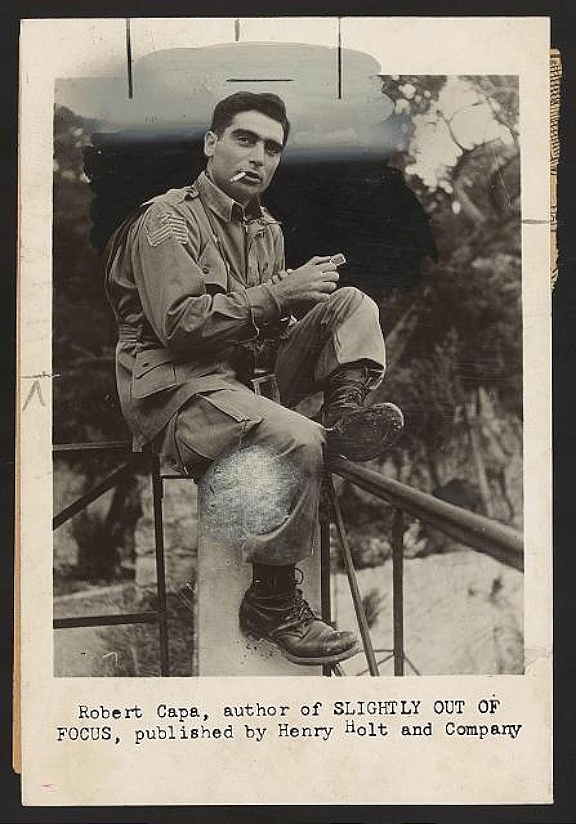
Robert Capa, publicity photo for “Slightly Out of Focus,” 1947.
Back in Weymouth on the morning of June 7 (as confirmed by the U.S. Coast Guard) after his brief but fraught trip to the beachhead at Normandy, Capa writes,
“I was treated as a hero. I was offered a plane to take me to London to give a broadcast of my experience. But I still remembered the night enough, and refused. I put my films in the press bag, changed my clothes, and returned to the beachhead a few hours later on the first available boat.”
He thus had a chance to put his precious, eagerly awaited films directly into the hands of John Morris within an hour (Weymouth is roughly 136 miles from London, a short hop by plane). Instead, self-confessedly riddled with guilt, “I put my films in the press bag, changed my clothes, and returned to the beachhead a few hours later on the first available boat,” arriving “[b]ack on the beachhead that night.” Perplexingly, he then adds,
“The day was D-plus-two [which would make it June 8], … and the party [in the press camp] was a French wake in my honor. I had been reported dead by a sergeant who had seen my body floating on the water with my cameras around my neck. I had been missing for forty-eight hours, my death had become official, and my obituaries had just been released by the censors.”
Hmmm. Did he not get back to Normandy till the morning of the 8th? David Scherman, who met the Chase when it docked back in England and made Capa’s portrait immediately upon landing, insists that it came into Portsmouth on the evening of the 6th, according to Richard Whelan’s authorized 1985 Capa biography. Be all that as it may, Whelan also states, Capa “gave [his films] to an Army public-relations officer for transport by courier to London.” Inexplicably, it took 12 hours or more for the films to reach Morris via courier. If you believe the legend, then, this decision of Capa’s created the extreme deadline pressure that resulted in the destruction of his images.
Should we believe it?
… and When Did He Know It?
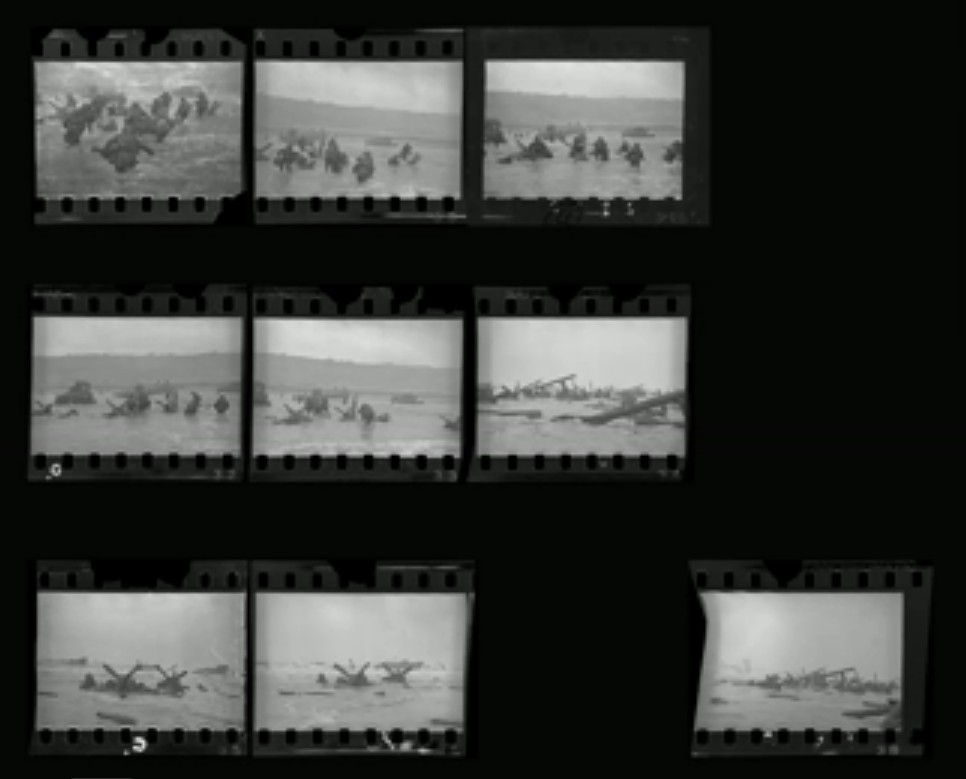
Robert Capa, D-Day frames from 6 June 1944. Courtesy Wikimedia Commons.
And should we believe Morris and Capa?
A few days after June 6, Capa told a colleague, TIME correspondent (and head of TIME and LIFE‘s European staff) Charles Wertenbaker, that he left Omaha Beach because “I shoot for an hour and a half and then all my film is used up.” (As quoted in Whelan’s biography.) But it’s simply impossible that Capa went to Normandy with only four rolls of 36-exposure 35mm film, three of which he expended on pre-landing images made aboard the U.S.S. Chase.
Written several years after D-Day, Capa’s memoir makes no such claim; it proves unsparingly honest in its description of his terror on Omaha Beach as the motive for his abrupt departure, just minutes after arriving. Perhaps because he wrote much of that book (even dictating parts of it) well past his publisher’s deadline, without any fact-checking (per Whelan’s introduction to the 2001 Modern Library reprint edition), it contains assorted errors of fact.
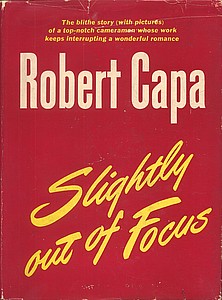
Robert Capa, “Slightly Out of Focus” (1947), cover.
But such issues seem trivial compared to the primary one: What images had he made at Omaha Beach, and what actually happened to his films once they reached John Morris in London? By the time he drafted Slightly Out of Focus Capa had had ample opportunity to examine his remaining film, including the samples of supposedly “ruined” negatives. Even if no one else had told him so, he knew these frames did not represent catastrophic emulsion melt. He also knew how many rolls of film he’d exposed at Omaha Beach, and how many images he’d made there. He had the opportunity right then to correct the misleading account that had circulated widely.
Yet that would have embarrassed not just him but his close friend John Morris and everyone else involved in the cover-up, not to mention all those who’d unknowingly promulgated this fable. So, instead, he doubled down on it:
“Seven days later I learned that the pictures I had taken on ‘Easy Red’ were the best of the invasion. But the excited darkroom assistant, while drying the negatives, had turned on too much heat and the emulsions had melted and run down before the eyes of the London office. Out of one hundred and six pictures in all, only eight [sic] were salvaged. The captions under the heat-blurred pictures read that Capa’s hands were badly shaking.”
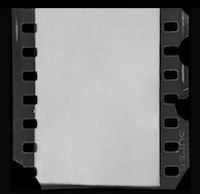
* “Behind the Photo: Robert Capa’s D-Day” (2014), screenshot
So far as I can determine, this represented the debut appearance in print of the heat-damaged negatives story, coming straight from the horse’s mouth, thus making it official. Capa therefore created two indelible images of D-Day: first, the one of the wounded Huston Riley gamely making his way to shore; and, second, the one of the melted emulsions of his Omaha Beach negatives dripping down in front of people’s eyes in a London darkroom.
Birth of A Factoid
So when Mia Tramz, in the brief text accompanying “Behind the Photo: Robert Capa’s D-Day,” a brief TIME video from May 29, 2014, writes, “[A]lthough Capa shot approximately 106 frames on the beach, only a handful have survived,” she’s simply perpetuating what has become an institutionally endorsed lie.

Mia Tramz, from text accompanying “Behind the Photo: Robert Capa’s D-Day,” TIME video, May 29, 2014.
Not satisfied even with that great exaggeration, “investigative journalist” Marie Brenner, in her hagiography for Vanity Fair, takes it to the max, writing in hyperventilated prose, “Capa, who prided himself on not knowing what he shot, knew exactly what he had that day: four rolls full of what could well be the most stirring images of warfare ever created.” Sheer hyperbole, of course; she’s the first to claim that Capa made four rolls of exposures at Omaha Beach.

Marie Brenner, quote from “Robert Capa’s Longest Day,” Vanity Fair, June 2014.
This sequence — from Capa to Tramz to Brenner — serves as a perfect example of how what Norman Mailer dubbed “factoids” (which he defined as “facts which have no existence before appearing in a magazine or newspaper [or book]”) get introduced and disseminated, morphing variously along the way, perpetuated and amplified by lazy journalists and people with something to gain from their currency.
Fish Story
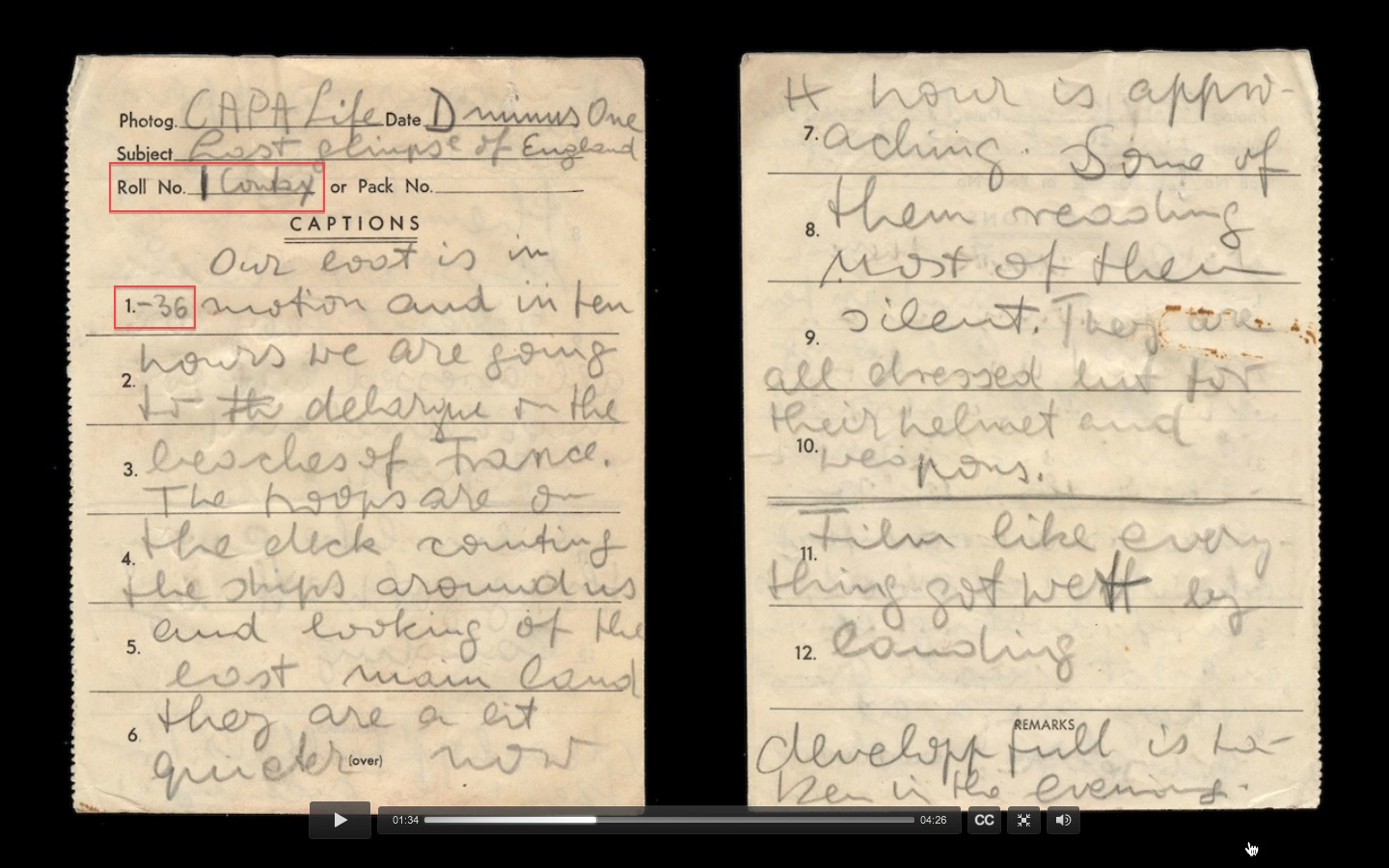
Robert Capa, D-Day image captions, Contax 35mm Roll 2.
Capa himself knew that three of those rolls had been used aboard the U.S.S. Chase at dockside in England and en route to Normandy; he said so in his handwritten caption notes for Morris that accompanied the films, who knew this as soon as he read those notes. And Capa knew he’d made all his Omaha Beach exposures — those on the fourth roll — from the LCI, from waist-deep in the surf, and then from the edge of the beach, during the first few minutes of the battle.
When he ran for that outgoing LCI, did he have reason to believe that he had fulfilled his assignment, enough so to give LIFE‘s readers what they expected — a front-row seat at the landing? I have to answer no. A mere 11 exposures made in half an hour at the very beginning of the battle could not have guaranteed that he’d delivered the goods. However much I empathize, on a purely human level, with his compulsion to retreat from the maw of hell, I have to assess it as fundamentally unprofessional.
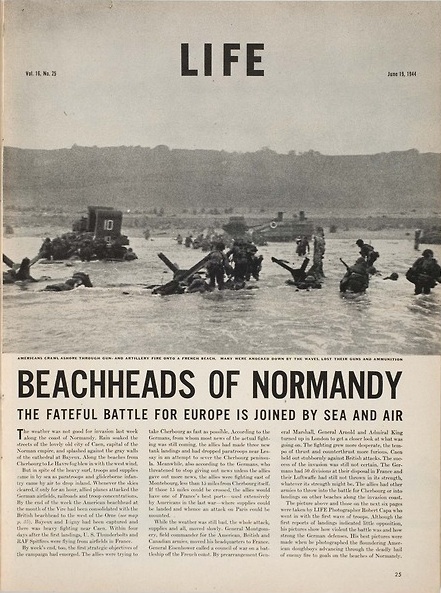
“Beachheads of Normandy,” LIFE magazine feature on D-Day with Robert Capa photos, June 19, 1944.
In the LIFE story published on June 19, 1944, under the headline “Beachheads of Normandy: The Fateful Battle for Europe Is Joined by Sea and Air,” the text claimed that “As [Capa] waded out to get aboard, his cameras were thoroughly soaked.” Hardly.
According to Richard Whelan’s biography, “In his cable congratulating Capa for the best coverage of the invasion, [LIFE Picture Editor] Wilson Hicks told the photographer that the lost pictures had been ruined by seawater that had seeped into his cameras. Capa did not learn the truth until he returned to London in July.” But of course Capa — having reloaded those cameras immediately upon reaching the safety of the evacuation boat, he tells us — would have known immediately upon reading this cable that no seawater had entered his cameras to damage those films. (Click here to view the LIFE story, which included 5 of Capa’s Omaha Beach images.)
The Ones that Got Away
Without question, he also knew he’d sent Morris only one roll of Omaha Beach exposures, with only 11 exposures on it. “The little which got printed is nothing compared to the material which they got ruined,” Capa wrote to his brother Cornell in New York City, according to Brenner. Sadly, the evidence shows that this amounted to nothing more than a fish story about the ones that got away.
Robert Capa unquestionably had the skills required to make astonishing images at Omaha Beach on D-Day. He presented himself with his camera and lens at the historic setting from which he could have derived such images. But he pressed the shutter release a mere 11 times; that’s all he registered on his one roll of D-Day film. On this crucial occasion, the opportunity of a lifetime, he failed himself, his picture editor, his publisher, his public, and history itself.
•
(For an index of links to all posts in this series, click here.)
[Note: Subsequent research by Rob McElroy revealed that all supposed examples of Capa’s “damaged” D-Day negatives published in the May 29, 2014 TIME video, such as the one above (*), were forgeries produced by Magnum in collusion with the International Center of Photography. While this renders irrelevant the above analysis of those frames, it does not undermine my broader challenge to the “melted emulsion” narrative. — A. D. C.]
•
John Morris will participate in a conversation with Robert Pledge, founder and director of Contact Press Images, at the International Center of Photography on June 24, 2014. They’ll stream it, so you can watch it live online at www.icp.org/live. Clicking on that link will enable you to submit a question in advance.
Alternate History: Robert Capa on D-Day (6)
In the previous post in this series, I looked at Robert Capa’s own account of his experiences at Omaha Beach on June 6, 1944, in his 1947 memoir, Slightly Out of Focus. Here we pick up his narrative after he escapes on a hospital evacuation ship — coincidentally the U.S.S. Samuel Chase, the same vessel that had brought him there, now heading back to England from Normandy.
•
“I woke up on a bunk. My naked body was covered with a rough blanket. On my neck, a piece of paper read, ‘Exhaustion case. No dog tags.’ My camera bag was on the table, and I remembered who I was.
“In the second bunk was another naked young man, his eyes staring at the ceiling. He said, ‘I am a coward.’ He was the only survivor from the ten amphibious tanks that had preceded the first waves of infantry. … During the night the man from the tank and I both beat our breasts, each insisting that the other was blameless, that the only coward was himself.”
•
Robert Capa, publicity photo for “Slightly Out of Focus,” 1947.
Back in Weymouth on the morning of June 7 (as confirmed by the U.S. Coast Guard) after his brief but fraught trip to the beachhead at Normandy, Capa writes,
“I was treated as a hero. I was offered a plane to take me to London to give a broadcast of my experience. But I still remembered the night enough, and refused. I put my films in the press bag, changed my clothes, and returned to the beachhead a few hours later on the first available boat.”
He thus had a chance to put his precious, eagerly awaited films directly into the hands of John Morris within an hour (Weymouth is roughly 136 miles from London, a short hop by plane). Instead, self-confessedly riddled with guilt, “I put my films in the press bag, changed my clothes, and returned to the beachhead a few hours later on the first available boat,” arriving “[b]ack on the beachhead that night.” Perplexingly, he then adds,
“The day was D-plus-two [which would make it June 8], … and the party [in the press camp] was a French wake in my honor. I had been reported dead by a sergeant who had seen my body floating on the water with my cameras around my neck. I had been missing for forty-eight hours, my death had become official, and my obituaries had just been released by the censors.”
Hmmm. Did he not get back to Normandy till the morning of the 8th? David Scherman, who met the Chase when it docked back in England and made Capa’s portrait immediately upon landing, insists that it came into Portsmouth on the evening of the 6th, according to Richard Whelan’s authorized 1985 Capa biography. Be all that as it may, Whelan also states, Capa “gave [his films] to an Army public-relations officer for transport by courier to London.” Inexplicably, it took 12 hours or more for the films to reach Morris via courier. If you believe the legend, then, this decision of Capa’s created the extreme deadline pressure that resulted in the destruction of his images.
Should we believe it?
… and When Did He Know It?
Robert Capa, D-Day frames from 6 June 1944. Courtesy Wikimedia Commons.
And should we believe Morris and Capa?
A few days after June 6, Capa told a colleague, TIME correspondent (and head of TIME and LIFE‘s European staff) Charles Wertenbaker, that he left Omaha Beach because “I shoot for an hour and a half and then all my film is used up.” (As quoted in Whelan’s biography.) But it’s simply impossible that Capa went to Normandy with only four rolls of 36-exposure 35mm film, three of which he expended on pre-landing images made aboard the U.S.S. Chase.
Written several years after D-Day, Capa’s memoir makes no such claim; it proves unsparingly honest in its description of his terror on Omaha Beach as the motive for his abrupt departure, just minutes after arriving. Perhaps because he wrote much of that book (even dictating parts of it) well past his publisher’s deadline, without any fact-checking (per Whelan’s introduction to the 2001 Modern Library reprint edition), it contains assorted errors of fact.
Robert Capa, “Slightly Out of Focus” (1947), cover.
But such issues seem trivial compared to the primary one: What images had he made at Omaha Beach, and what actually happened to his films once they reached John Morris in London? By the time he drafted Slightly Out of Focus Capa had had ample opportunity to examine his remaining film, including the samples of supposedly “ruined” negatives. Even if no one else had told him so, he knew these frames did not represent catastrophic emulsion melt. He also knew how many rolls of film he’d exposed at Omaha Beach, and how many images he’d made there. He had the opportunity right then to correct the misleading account that had circulated widely.
Yet that would have embarrassed not just him but his close friend John Morris and everyone else involved in the cover-up, not to mention all those who’d unknowingly promulgated this fable. So, instead, he doubled down on it:
“Seven days later I learned that the pictures I had taken on ‘Easy Red’ were the best of the invasion. But the excited darkroom assistant, while drying the negatives, had turned on too much heat and the emulsions had melted and run down before the eyes of the London office. Out of one hundred and six pictures in all, only eight [sic] were salvaged. The captions under the heat-blurred pictures read that Capa’s hands were badly shaking.”
* “Behind the Photo: Robert Capa’s D-Day” (2014), screenshot
So far as I can determine, this represented the debut appearance in print of the heat-damaged negatives story, coming straight from the horse’s mouth, thus making it official. Capa therefore created two indelible images of D-Day: first, the one of the wounded Huston Riley gamely making his way to shore; and, second, the one of the melted emulsions of his Omaha Beach negatives dripping down in front of people’s eyes in a London darkroom.
Birth of A Factoid
So when Mia Tramz, in the brief text accompanying “Behind the Photo: Robert Capa’s D-Day,” a brief TIME video from May 29, 2014, writes, “[A]lthough Capa shot approximately 106 frames on the beach, only a handful have survived,” she’s simply perpetuating what has become an institutionally endorsed lie.
Mia Tramz, from text accompanying “Behind the Photo: Robert Capa’s D-Day,” TIME video, May 29, 2014.
Not satisfied even with that great exaggeration, “investigative journalist” Marie Brenner, in her hagiography for Vanity Fair, takes it to the max, writing in hyperventilated prose, “Capa, who prided himself on not knowing what he shot, knew exactly what he had that day: four rolls full of what could well be the most stirring images of warfare ever created.” Sheer hyperbole, of course; she’s the first to claim that Capa made four rolls of exposures at Omaha Beach.
Marie Brenner, quote from “Robert Capa’s Longest Day,” Vanity Fair, June 2014.
This sequence — from Capa to Tramz to Brenner — serves as a perfect example of how what Norman Mailer dubbed “factoids” (which he defined as “facts which have no existence before appearing in a magazine or newspaper [or book]”) get introduced and disseminated, morphing variously along the way, perpetuated and amplified by lazy journalists and people with something to gain from their currency.
Fish Story
Robert Capa, D-Day image captions, Contax 35mm Roll 2.
Capa himself knew that three of those rolls had been used aboard the U.S.S. Chase at dockside in England and en route to Normandy; he said so in his handwritten caption notes for Morris that accompanied the films, who knew this as soon as he read those notes. And Capa knew he’d made all his Omaha Beach exposures — those on the fourth roll — from the LCI, from waist-deep in the surf, and then from the edge of the beach, during the first few minutes of the battle.
When he ran for that outgoing LCI, did he have reason to believe that he had fulfilled his assignment, enough so to give LIFE‘s readers what they expected — a front-row seat at the landing? I have to answer no. A mere 11 exposures made in half an hour at the very beginning of the battle could not have guaranteed that he’d delivered the goods. However much I empathize, on a purely human level, with his compulsion to retreat from the maw of hell, I have to assess it as fundamentally unprofessional.
“Beachheads of Normandy,” LIFE magazine feature on D-Day with Robert Capa photos, June 19, 1944.
In the LIFE story published on June 19, 1944, under the headline “Beachheads of Normandy: The Fateful Battle for Europe Is Joined by Sea and Air,” the text claimed that “As [Capa] waded out to get aboard, his cameras were thoroughly soaked.” Hardly.
According to Richard Whelan’s biography, “In his cable congratulating Capa for the best coverage of the invasion, [LIFE Picture Editor] Wilson Hicks told the photographer that the lost pictures had been ruined by seawater that had seeped into his cameras. Capa did not learn the truth until he returned to London in July.” But of course Capa — having reloaded those cameras immediately upon reaching the safety of the evacuation boat, he tells us — would have known immediately upon reading this cable that no seawater had entered his cameras to damage those films. (Click here to view the LIFE story, which included 5 of Capa’s Omaha Beach images.)
The Ones that Got Away
Without question, he also knew he’d sent Morris only one roll of Omaha Beach exposures, with only 11 exposures on it. “The little which got printed is nothing compared to the material which they got ruined,” Capa wrote to his brother Cornell in New York City, according to Brenner. Sadly, the evidence shows that this amounted to nothing more than a fish story about the ones that got away.
Robert Capa unquestionably had the skills required to make astonishing images at Omaha Beach on D-Day. He presented himself with his camera and lens at the historic setting from which he could have derived such images. But he pressed the shutter release a mere 11 times; that’s all he registered on his one roll of D-Day film. On this crucial occasion, the opportunity of a lifetime, he failed himself, his picture editor, his publisher, his public, and history itself.
•
(For an index of links to all posts in this series, click here.)
[Note: Subsequent research by Rob McElroy revealed that all supposed examples of Capa’s “damaged” D-Day negatives published in the May 29, 2014 TIME video, such as the one above (*), were forgeries produced by Magnum in collusion with the International Center of Photography. While this renders irrelevant the above analysis of those frames, it does not undermine my broader challenge to the “melted emulsion” narrative. — A. D. C.]
•
John Morris will participate in a conversation with Robert Pledge, founder and director of Contact Press Images, at the International Center of Photography on June 24, 2014. They’ll stream it, so you can watch it live online at www.icp.org/live. Clicking on that link will enable you to submit a question in advance.